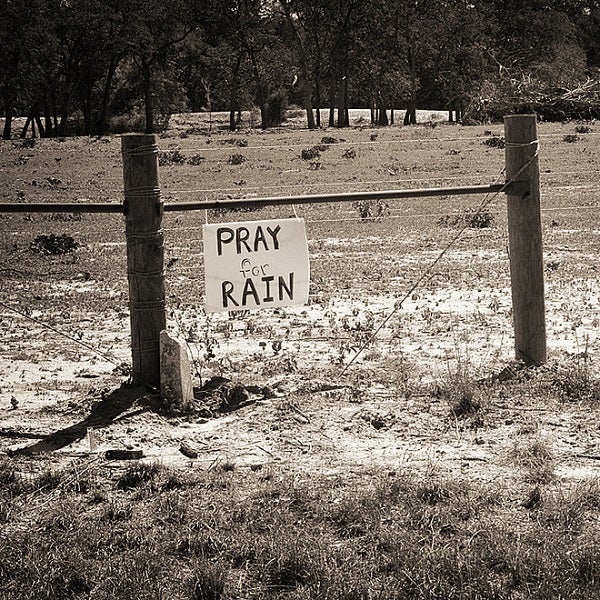Showtime Brings Realities of Texas Drought Home to Millions

It may seem like only yesterday that Texans were asked to conserve water after another scorching summer, but in reality it was four, dry years ago. The drought, which began in 2010 after La Niña altered sea level temperatures in the Pacific, continues to persist in the Lone Star State and promises to surpass the state’s record-setting multi-year drought from the 1950s. Ranchers have been forced to sell off cattle, town water supplies continue to go dry, and power plants struggle to provide a reliable supply of electricity due to water scarcity and long stretches of hot weather. Given these bleak conditions, it should not come as a surprise that 70 percent of Texans believe global warming is happening—and 52 percent said they have personally experienced the effects of global warming.
An all-star team of producers, including James Cameron, Jerry Weintraub and Arnold Schwarzenegger, intends to bring the Texas drought home to millions of televisions across the nation in the Years of Living Dangerously series premiering Sunday. Through this series, a host of celebrities, activists and journalists share the stories of those impacted most by our changing climate and what’s being done to save our planet. What is clear right now, in Texas and beyond, is that as climate change intensifies, we must adapt to more extreme weather conditions and make resilient changes that mitigate further stress.
Adapting to a hotter, drier climate
But don’t take my word for it. Texas State Climatologist and professor in the Atmospheric Sciences Department at Texas A&M University, John Nielsen-Gammon, has confirmed that the high temperatures experienced in 2011, which greatly exacerbated the drought, are, in fact, linked to a changing climate. The La Niña-related heat wave that prompted Texas’ extreme temperatures was made 20 times more likely by climate change. In his words: “We would have broken the record with this drought in terms of high temperatures even without climate change, but we ended up breaking it by quite a comfortable margin with climate change.” According to his estimates, Texans may expect a reprieve this year, to the benefit of ranchers and farmers, but nothing is certain, especially given extreme weather patterns are expected to increase in frequency and intensity in the future.
Arguably, the state’s agricultural sector was hit hardest during 2011, but water touches all of our lives and Texans across the state felt the environmental, societal, and economic costs. Ranchers and farmers lost nearly $8 billion during 2011, as crops wilted, cattle were sold off, and utilities shut off water to farms, which inevitably sent food prices across the nation soaring. The state’s water supplies either evaporated completely or shrank to alarming levels, and they have yet to be fully replenished. But the most tragic consequence came in the form of wildfires, which swept across densely-populated Central Texas and burned over 1,000 homes in its wake. As ‘Years of Living Dangerously’ will aptly depict, Texans are already adapting to a hotter, drier climate.
Years of Living Dangerously
Don Cheadle will kick off the new series this Sunday, as he travels to Plainview and Lubbock, Texas to meet with ranchers, Texas Tech Climate Scientist Katharine Hayhoe and others as they share how their lives are impacted by the drought. EDF’s own leadership, Fred Krupp and Eric Pooley, participated on the advisory board for this film, along with several other thought-leading experts and environmental advocates. For a sneak peak, watch here. For my fellow Texans and me, the drought has been at the top of our minds for the past four years and will be for many more. And as climate change intensifies, many other Americans will also face the water scarcity issues we Texans are too familiar with. Most of the western-half of the United States is currently in the midst of a drought and California, in particular, is reeling from the effects. In fact, California’s conditions are very similar to those in Texas back in 2011, which means rising food prices and devastating wildfires are soon to follow, and the impacts will be felt far beyond its borders.
At EDF, we are seeking solutions that reduce our dependence on fossil fuel generation, which emits extreme amounts of climate-altering greenhouse gas emissions and requires an abundant amount of water. The U.S. has the potential to adopt technologies and policies that will significantly cut down on water use, reduce the need for dirty fossil fuel power plants, and help Americans save money. By lining up the incentives to enable novel energy and water savings – such as implementing the widespread use of wind and solar energy, which consume little to no water and generate negligible carbon emissions – we can ensure America’s faucets remain flowing during the next record-setting drought and beyond.
This commentary originally appeared on our EDF Voices blog.










